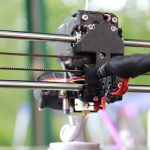How IoT Is Used on the Production Floor
- Featured StoriesManufacturingTechnology
- May 25, 2022
Quick navigation
ToggleFast Radius illustrates the most relevant and beneficial applications of IIoT in manufacturing.
The Internet of Things (IoT) is a broad category including devices that leverage sensors, processing chips or software to gather and exchange data over the internet or another connected network. Today, everything from medical devices to consumer home goods make use of connected solutions. In fact, nearly 36 billion IoT devices were installed by the end of 2021—a number that’s expected to leap to more than 75 billion by 2025.
In the manufacturing space, there are a multitude of reasons for manufacturers to embrace IoT and the Industrial Internet of Things (IIoT). Higher consumer expectations, growing interest in customization and the increasing complexity of global supply chains are just a few examples that require businesses across market sectors to think creatively about how to revamp their operations. IIoT adoption has the potential to create hyper-connected systems that facilitate real-time production and shipment monitoring, improve process control and inform analytics-based insights to drive greater efficiency and productivity. The monetary benefit of adopting IoT solutions is also becoming clear—McKinsey estimates that IoT applications could have a global economic impact of $3.9 trillion to $11.1 trillion per year by 2025.
Key Applications for IIoT and Smart Manufacturing
Monitoring Equipment Utilization
IIoT solutions designed for monitoring machine utilization capture real-time metrics from production equipment, which increases productivity and optimizes production schedules. Smart sensors collect data related to a machine’s operating parameters—such as run time, operating speed and output—which are then sent to a cloud-based server for aggregation and analysis. These insights about important utilization performance indicators like TEEP can be used to drive predictive maintenance efforts.
How to protect your business from hacking
Business March 31, 2021
3D Printing Trends in 2024
3D Printing September 16, 2024
Custom Manufacturing Market 2022-2029
Business August 10, 2022
Which is the world's smartest robot?
Business June 24, 2022
Guide for Commercial 3D Model Marketplaces
Experience November 5, 2024
3D Printing Trends in 2024
3D Printing September 16, 2024
Parametric Modeling in CAD and industrial design
3D modeling April 9, 2023
Cost Reduction
IIoT tools like RFID solutions provide visibility into warehousing and inventory management. This can be used to reduce inventory carrying costs and search times, minimize machine downtime and gain a more accurate estimate of materials currently available. IIoT solutions can also be used to track the speed and flow of raw materials during transport, improving handling times and processing efficiency.
Improved Safety
IIoT solutions and big data analytics can also be applied to worker safety within a manufacturing site. Wearable devices can track employee health metrics in real-time, including exposure to fumes, heart rate, movement speed and other factors. These solutions can also be used to monitor performance indicators such as machinery damage, worker absences and other operations-related mishaps to help keep safety events to a minimum.
The Future of IIoT in Manufacturing
Although IIoT solutions are already revolutionizing how the manufacturing and industrial spaces operate, they are still relatively new. The future holds a great deal of promise when it comes to IIoT trends in manufacturing.As more forms of manufacturing hardware become outfitted with sensors and chips, interrelated connected technologies will allow for the capture of more types of data that can be fed into analytics engines, making it possible to optimize operational processes even further. Simulation tools and platforms are likely to play a central role in minimizing waste and optimizing design and manufacturing processes. Automation can also improve the accuracy of manufacturing processes, the safety of workers and the operational efficiency of manufacturing sites when combined with IIoT solutions.
Getting Started with IIoT-Powered Manufacturing
IIoT solutions leverage the power of interconnected devices and machines to create actionable insights for manufacturers and product teams that streamline processes and improve manufacturing outcomes. Embracing IIoT tools and principles allows manufacturers to create new efficiencies, operate with greater precision and generate the type of real-time insights that are critical to providing modern, transparent and cost-effect manufacturing.For engineers and procurement professionals seeking the manufacturing and supply chain benefits of Industry 4.0—like the precision, insights and efficiency of IIoT production—now is the time to start leveraging like-minded production partners and capitalizing on the value of the IIoT.
Learn more at Fast Radius.








